North Carolina’s lush, diverse ecosystems come alive partly thanks to nature’s most diligent pollinators—bees. Within this picturesque landscape, an incredible variety of bee species thrive, each with its unique appearance, behaviors, and contributions to the local ecosystem.
The professionals at Stomp Pest Control have helped hundreds of North Carolina homeowners identify and address bee species in and around their homes, developing unique and affordable treatment plans for every customer. That means we’re pretty well-versed in the diversity of North Carolina bees and their behaviors: From the familiar honey bee to the less-known mason bees, we’re using that knowledge to delve into the buzzing biodiversity of these essential insects.
Here’s a guide to some of the most common types of bees you may come across in North Carolina.
Western Honey Bees
Western honey bees are one of the most well-known species of North Carolina bees. They are typically about half an inch long and have a yellow-brown to black coloration. They have a distinct, alternating black and yellow stripe pattern, and possess a set of delicate, transparent wings that allow them to dart swiftly from flower to flower.
Honey bees create large colonies in hives, often in hollow trees, buildings, or man-made beehives. They are highly social insects, living in large colonies with a well-defined hierarchy that includes a queen, worker bees, and drones. They are diligent foragers, collecting nectar and pollen to produce honey, a valuable food source for the colony.
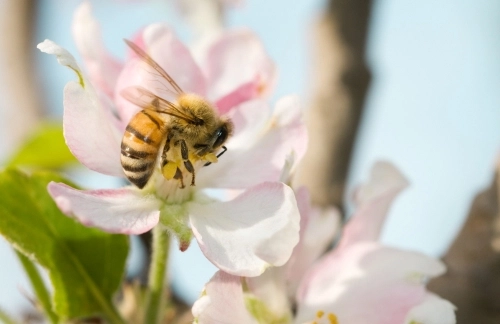
While generally docile, western honey bees will vigorously defend their hive if threatened, and their stings can be painful, particularly for individuals with allergies. Nevertheless, their importance as pollinators and honey producers makes them invaluable contributors to North Carolina’s ecosystems and agriculture.
Bumble Bees
Bumblebees are easily recognizable among other species of North Carolina bees by their robust and fuzzy appearance, characterized by vibrant black and yellow stripes along their adorably plump bodies, which can range from half an inch to an inch in length.
These charming insects are social by nature, forming colonies with a queen, worker bees, and drones. Bumblebees are known for their distinctive buzzing flight patterns, often seen hovering over flowers while foraging for nectar and pollen. They are exceptionally effective pollinators due to their bumbling flight style, which results in pollen transfer between plants.
Generally, bumblebees are not overly aggressive; however, they will defend their nests if threatened. When provoked, their sting can be painful but is typically less potent than that of a honeybee. Despite their stinging capability, bumblebees play a crucial role in pollinating a variety of plants.
Carpenter Bees
Carpenter bees, with their large bodies, have a distinctive appearance that often includes a shiny black abdomen. Some species may feature yellow markings.
These solitary bees are known for their nesting behavior, as they create tunnels by drilling into wood, such as decks, eaves, or fences. Unlike social bees, carpenter bees do not form colonies, and each female is responsible for her own nest.
While they are generally not aggressive and prefer to go about their business, females are equipped with stingers and can sting if provoked or handled roughly. However, they are less likely to sting than other common North Carolina bees, like honey bees and bumble bees. They are most commonly found in wooded areas, or in and around man-made wooden structures.
Mason Bees
As their name suggests, mason bees are renowned for their impressive skills as builders.
They can most easily be spotted by their small size—between 0.3 and 0.6 inches—and metallic blue or green sheen.
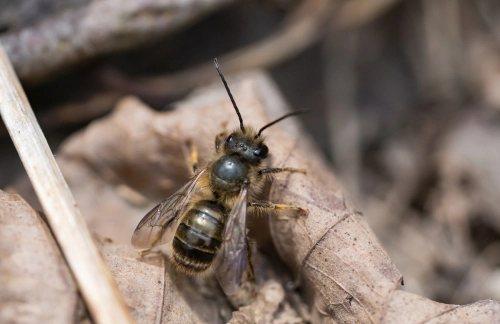
These solitary bees are not social and do not form colonies. Instead, they are known for their nesting behavior, which involves using existing holes or cavities, such as hollow plant stems or holes in wood, to create individual nests. You may notice mud partitions in their nests, which are a tell-tale sign that a mason bee did the building.
These North Carolina bees are gentle and rarely aggressive, making them unlikely to sting humans unless handled roughly or threatened directly. When they do sting, their stings are typically mild and not as painful as those of some other bee species.
Leafcutter Bees
Leafcutter bees are distinct in their appearance, typically measuring about the same size as honeybees (around 0.5 inches) but featuring a unique appearance with predominantly black bodies adorned with pale stripes.
This species of North Carolina bee is best best-known for its nesting behavior, which involves cutting small pieces of leaves to line their nests, giving them their name. Their nests can be found in cavities or hollow plant stems in many gardens, meadows, and wooded areas.
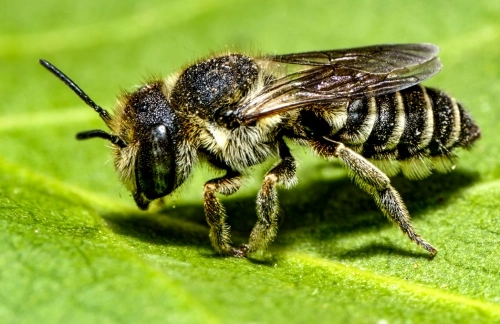
Leafcutter bees are gentle by nature and rarely sting, even when provoked. Their stings are generally mild and not considered a significant threat to humans.
Mining Bees
Mining bees, often characterized by their small to medium size, have relatively simple and unadorned appearances compared to other common North Carolina bees, with dark-colored bodies that may have subtle markings.
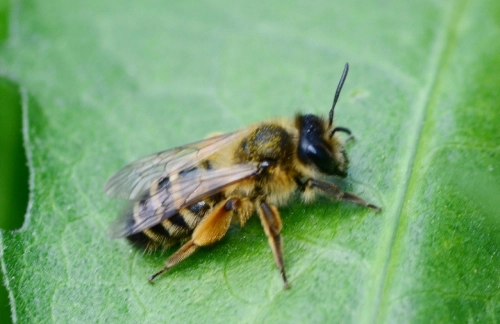
These bees, like the mason bee, are named for their nesting behavior, as they create burrows in the ground, where they lay their eggs. You might notice a small mound of soil left behind in a spot where a mining bee has burrowed, evidence of their efforts.
Mining bees are generally gentle and non-aggressive, rarely stinging humans even when approached or handled. If they do sting, their stings are typically mild and not considered particularly painful or harmful.
Sweat Bees
Sweat bees are named and known for their attraction to human perspiration. They are small in size, ranging from a quarter to half an inch in length, and they come in various colors, including metallic greens, blues, and browns.
Their diminutive size and often vibrant colors set them apart from other species of North Carolina bees. These solitary species are generally docile and not aggressive, making them unlikely to sting humans unless directly threatened or mishandled. When they do sting, the pain is usually mild and short-lived.
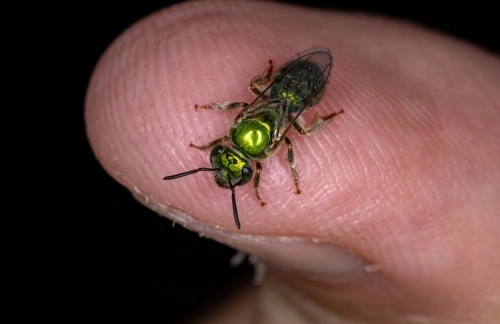
Let Stomp Pest Control Help with North Carolina Bees
It’s important to remember that most bees are essential for pollination, which supports the growth of fruits, vegetables, and many other plants. When encountering North Carolina bees, it’s best to observe them from a safe distance and avoid swatting or disturbing them to minimize the risk of stings.
However, if you have concerns about North Carolina bees or nests in or near your home, consider consulting with our pest control experts for safe removal options. At Stomp Pest Control, we’ve been providing pest control service to much of the Greater Triangle and Central North Carolina area for years, with the experience and tools to safely remove pests around and in your home. Call us today at (919) 231-3292 or fill out the form below to learn more!
Contact Form
We would love to hear from you! Please fill out this form and we will get back to you shortly.

